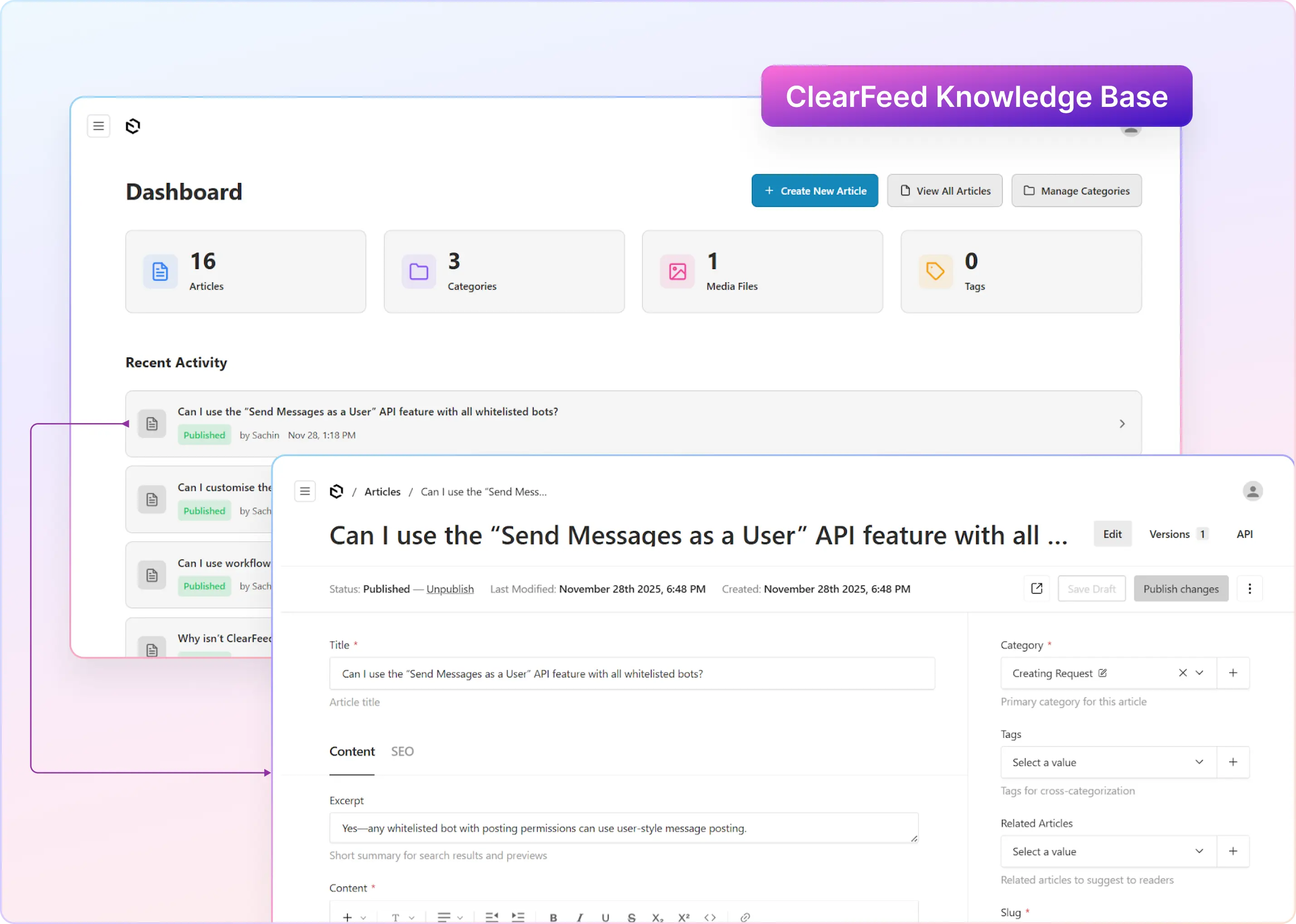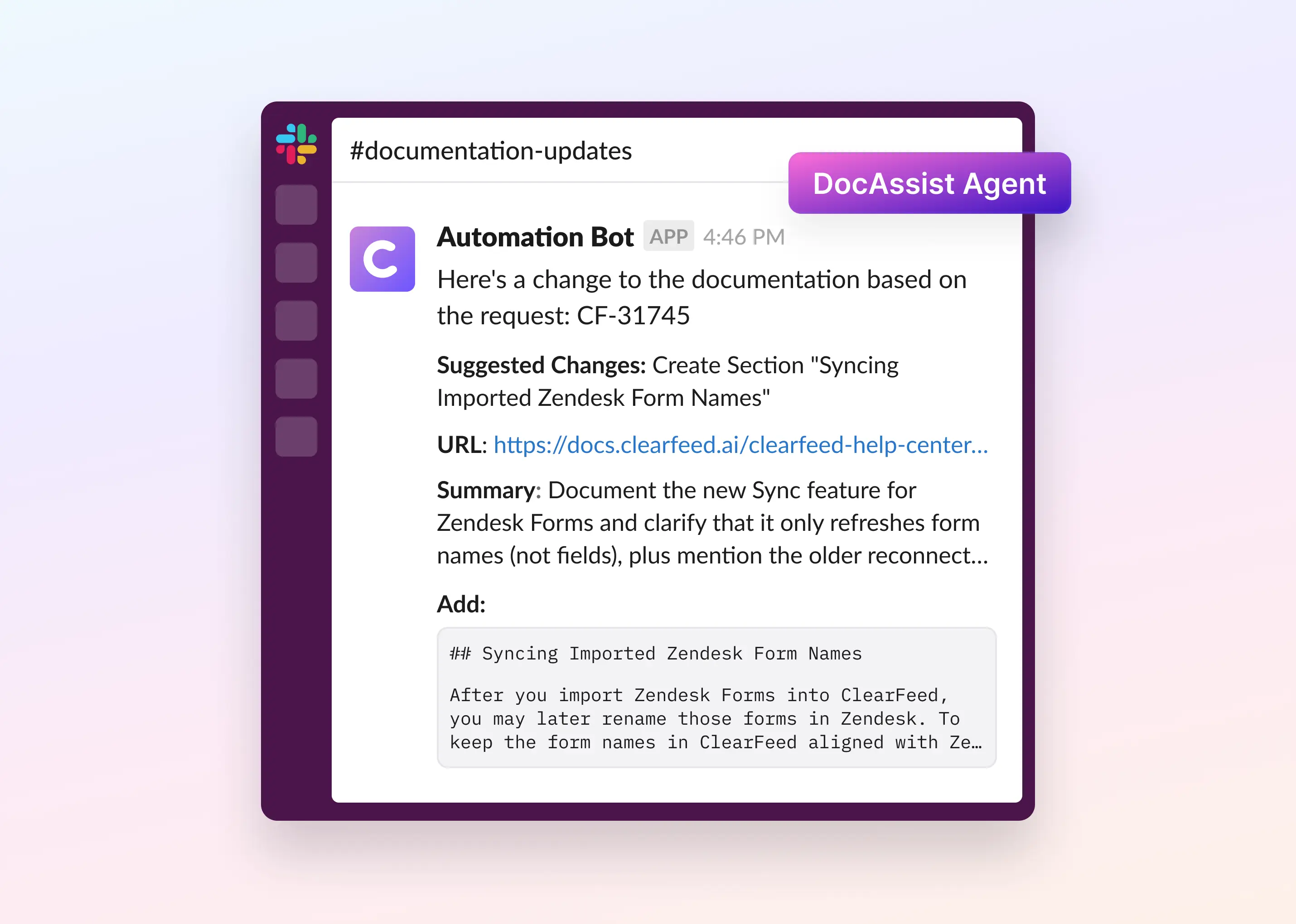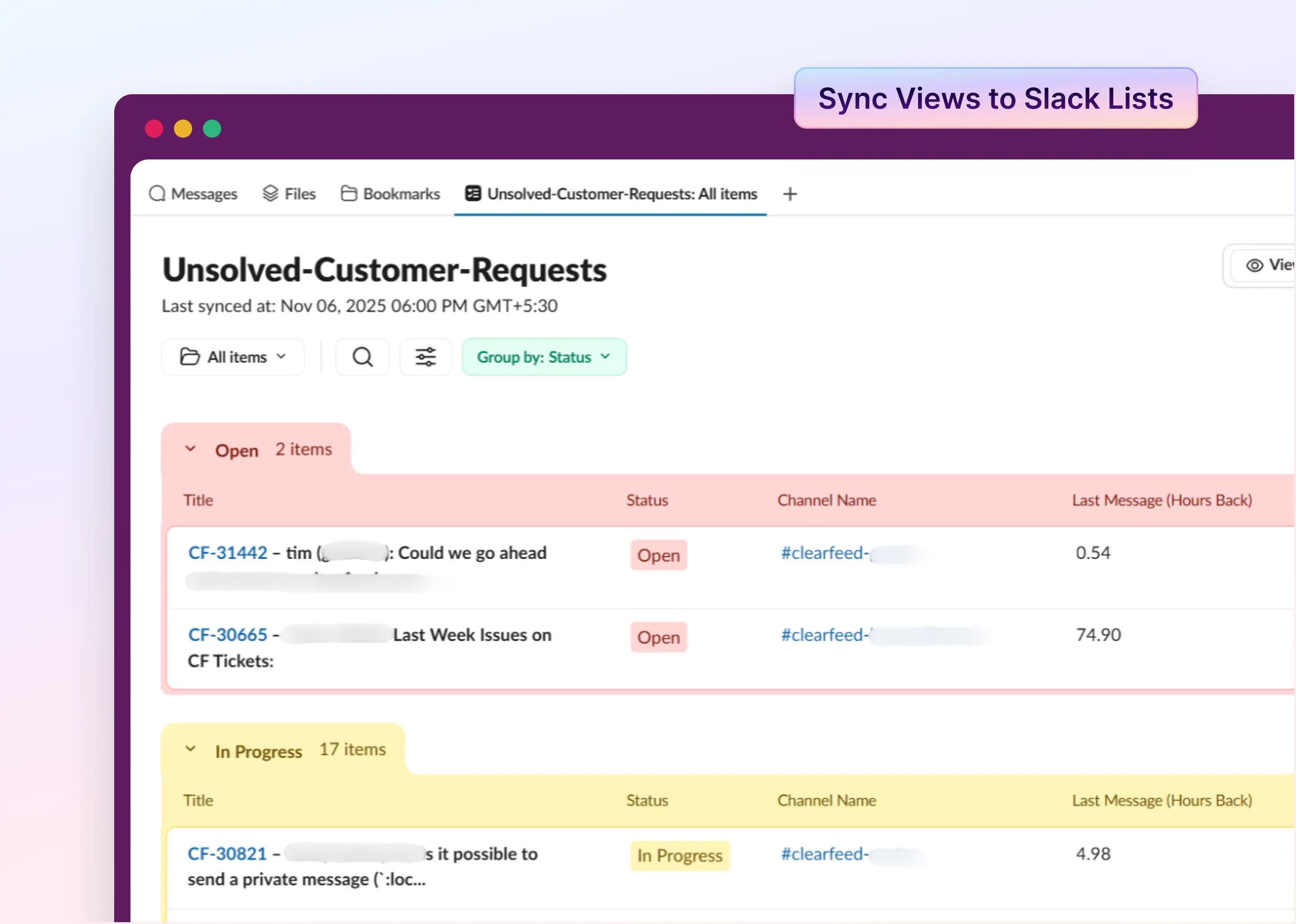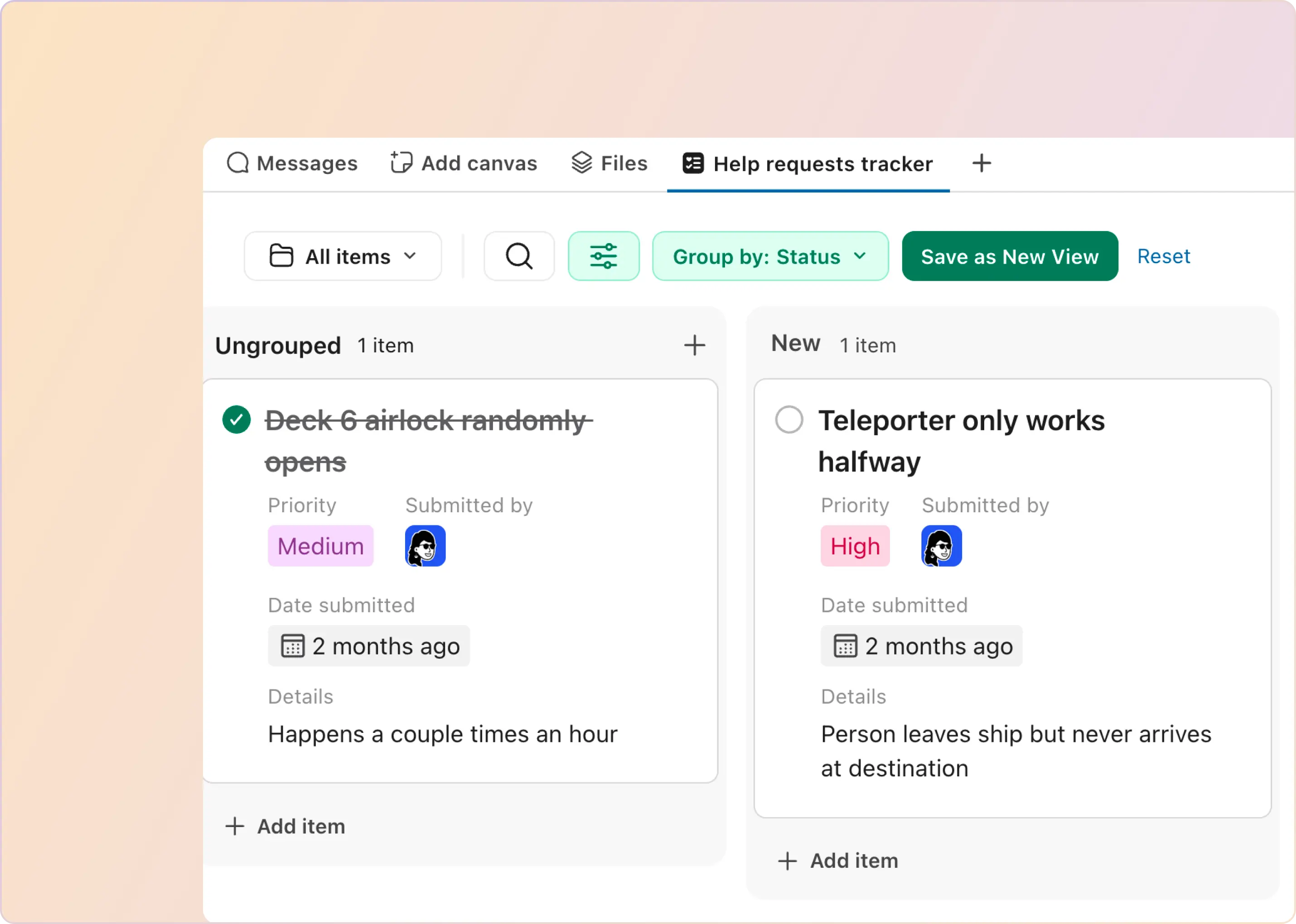Slack for customer support is not just an experiment anymore. It is now the main way many B2B companies talk to their customers every day. Instead of using email or help portals, customers can message you directly in Slack Connect channels. This is where your team and their team already work together.
Over 100,000 businesses use Slack today. That includes 77 of the top 100 companies in the Fortune 100 list. More and more of these businesses are offering customer support through Slack for their most important clients.
In simple terms, "Slack for customer support" means handling support tickets, questions, and urgent issues directly inside Slack. Customers message you in shared channels or direct messages, and your team can answer in real time.
But if you do not have a plan, those messages and quick questions can get lost across different chats and people. This guide will show you how to run support smoothly inside Slack.
What Are the Benefits of Using Slack for Customer Service and Support?
Using Slack for customer support gives your team a single place to collaborate with customers and internal experts, resolve issues faster, and keep everyone aligned on context.
- Faster resolution through collaboration: Agents can quickly pull in engineers or PMs, swarm issues in a shared thread, and close loops in real time.
- High visibility and shared context: Messages, files, and decisions live in one place. Leaders can scan channels, spot risks, and step in before problems escalate.
- Personal, white-glove experience: Dedicated Slack channels feel natural and high-touch for key accounts, much more conversational than email tickets.
- Centralized knowledge and search: Past threads and files are easy to search. Topical channels give instant context on previous conversations and decisions.
- Easy adoption and onboarding: Most teams already live in Slack. New hires can ramp faster by reading real customer conversations and pinned resources instead of static docs.
The numbers back this up: companies using Slack for support see 36% faster case resolution and a 12% increase in customer satisfaction. However, the most compelling reason to use Slack is the bottom line. Research shows 58% of customers in one study said they would pay more if they knew they would receive excellent customer service. By investing in better customer service through Slack, you're boosting your revenue potential.
When Is Slack a Good Choice for Customer Support?
Using Slack for customer support works extremely well in some setups and less so in others. It tends to shine when:
- Your customers already use Slack. B2B users (SaaS, infra, developer tools) adapt quickly, as Slack is already a part of their daily workflow.
- You value personal, conversational support. For high-touch accounts with dedicated CSMs or AMs, Slack makes interactions feel more direct and human than email tickets.
- Support volume is moderate. Dozens to a few hundred active conversations can be handled smoothly with good triage and automation. Beyond that, you’ll want structured channels or a ticketing integration.
- Your product requires white-glove support: Complex B2B products often need hands-on onboarding and ongoing guidance. Slack is ideal for that high-touch, back-and-forth collaboration.
- Your team lives in Slack. Agents can loop in colleagues, share resources, and stay in one platform instead of constantly context-switching between tools.
- You’re ready to invest in automation. Slack isn’t a full helpdesk, but bots, workflow builders, and integrations can scale processes and keep SLAs under control.
When Slack Support Is Less Ideal
- Your customers aren’t on Slack. Broad consumer audiences often prefer email, phone, or a web portal/chat as their primary means of communication.
- Volume is very high. Hundreds or thousands of daily inquiries can overwhelm Slack without heavy automation. A helpdesk with Slack as a supplement is better here.
- Self-service is core to your strategy. Slack is great for products that need white-glove human service and support. It’s not meant for products where Support needs to be low-touch and largely self-service.
- Security or Slack Connect is a blocker. If customers can’t use Slack Connect or your organization's policies restrict external guests, traditional channels may be a safer option.
What Are the Limitations of Using Slack for Customer Support?
While powerful, Slack was never designed as a full-fledged helpdesk. If you’re using Slack for customer support as a primary channel, you’ll quickly run into some well-known limitations:
- Scalability: Free-form channels don’t scale well to hundreds of customers or thousands of requests. As volume grows, it becomes hard to see what’s open, what’s blocked, and what’s been resolved.
- Reporting: Native Slack doesn’t give you SLA reports, response time metrics, or resolution tracking out of the box. You can’t easily answer questions like “How long do we take to respond?” or “How many issues are still pending?”
- Search & Knowledge Management: Slack is not a structured knowledge base. Important resolutions get buried in long threads, and “just search Slack” quickly becomes unreliable as channels age and grow.
- Noise and Missed Messages: Without clear workflows or automation, critical customer requests can get buried under chatter. It’s easy for someone to reply in DMs or the wrong channel and lose context.
- Access Control and Channel Membership: Making sure the right people are in the right customer channels is painful at scale. Adding/removing engineers, CSMs, and specialists across hundreds of shared channels becomes a manual, error-prone task.
- Doesn't cover customers not on Slack: Many customers are on Microsoft Teams, or not on paid Slack plans (required for Slack Connect), or simply prefer email or web chat. Slack on its own doesn’t solve the omnichannel support challenge.
- Context Switching and Silo'ed Discussions: Slack is great for communication, but most companies rely on CRMs (HubSpot, Salesforce) and helpdesks (Zendesk, ClearFeed, Intercom, etc.) as the source of truth. By default, customer conversations in Slack don’t sync into these systems, so context gets trapped in chat. Moreover users have to work across these tools and Slack - leading to context switches.
- Cost: Slack Connect is free for companies on paid Slack plans, but customers on free plans can only join as guests, with limits on how many free guests are allowed. At scale, this can become a commercial and operational constraint.
More broadly, Slack is built around individuals and conversations, not teams managing queues. The lack of team-level views, reminders, or “my open tickets” dashboards makes serious support workflows hard to run natively. At ClearFeed, we hit these limits ourselves when we crossed 500+ customer channels and had to build processes and tooling to overcome exactly these challenges.
Which Companies Use Slack for Customer Support?
Most well-known SaaS, infrastructure, and AI vendors now offer Slack-based customer support as a premium or high-touch service. Examples include:
- DevOps platforms and observability platforms: Datadog, PagerDuty, Chronosphere
- Data infrastructure vendors: Snowflake, dbt Labs, Confluent, Astronomer
- Enterprise SaaS providers: Atlassian, Figma
- AI Vendors: OpenAI, RunwayML
Using Slack for customer support is especially popular in developer tools, data platforms, cloud infrastructure, and other complex B2B SaaS products—segments where customers already live in Slack all day and expect fast, collaborative support there.
Examples of Companies Using Slack as a Main Support Channel
Many B2B companies are providing most of their support on Slack (with Email and Chat only being used occasionnally). Some example firms:
- Astonomer: The company behind Apache Airflow. Most customer support is on Slack.
- testRigor: Company providing test automation services using AI - most customer interactions happen over Slack.
- ClearFeed: Company providing modern Slack-native helpdesks, has more than 500 Slack Connect channels.
What Are the Different Ways of Providing Customer Support via Slack?
There are three primary ways to use Slack for customer support:
1. Using Slack Directly for All Communication
Companies create shared Slack Connect channels with customers for direct, real-time communication. Support teams reply in customer channels and use private internal channels for side discussions.
- Benefits: Feels personal and high-touch, great for VIP or technical accounts, and builds trust and transparency.
- Team configuration: Support, Solutions, and Customer Success all work out of Slack with customers.
- Limitations: Hard to scale beyond a limited number of accounts without additional tools. It’s not a comprehensive strategy for supporting customers who aren’t on Slack.
2. Slack + Helpdesk Integration
Slack acts as the front-end for conversations, while requests are synced to a helpdesk (Zendesk, Intercom, Salesforce Service Cloud, HubSpot, etc.) for SLAs, escalations, and reporting. Customers not on Slack can still reach you via email or web forms that feed directly into Slack and then into the helpdesk.
- Benefits: Scales to a large number of customers, enforces SLAs, keeps metrics accurate, and consolidates customer conversations. Agents still enjoy Slack’s speed and collaboration when needed.
- Team configuration: The support team primarily works out of the helpdesk, while Solutions, Customer Success, and Product teams use Slack directly with customers.
- Considerations: Requires integration setup and clear workflows (e.g., when to auto-create tickets vs. agent-triggered). Teams must be explicit about what stays in Slack versus what must be logged in the helpdesk.
3. Using an Omnichannel Helpdesk With Built in Slack Connect Integration
In this model, a helpdesk handles email, web chat, portals, and Slack-based support natively. Many companies with a large number of customers on Slack use helpdesks like ClearFeed that treat Slack as a first-class channel.
- Benefits: Scales to a large number of customers on Slack, while also handling other channels consistently. Enforces SLAs, consolidates metrics and conversations, and still lets agents benefit from Slack’s real-time collaboration.
- Team configuration: The support team works out of the helpdesk as the system of record, while Solutions, Customer Success, and Product teams continue to collaborate with customers in Slack.
- Limitations: Slack conversations are conversational and chatty; without clear processes, it’s easy to mix up what belongs to Support versus Customer Success or other teams.
How To Use Slack for Customer Support?
Let’s walk through how to actually set up Slack for customer support so it functions as a reliable, structured support hub, while maintaining the informality of Slack:
1. Well defined channel structure and dedicated channel per Customer
Goal: Make it obvious where customers should ask for help.
- Create one Slack Connect channel per customer.
- If you work with multiple departments or projects, use multiple channels per account (e.g., ext-acme-prod, ext-acme-sandbox).
- Use a consistent naming convention like ext-<customer-name> so internal teams instantly recognize shared channels and their purpose.
2. Standardize Request Intake via Workflows or Emojis
Goal: Turn random pings into structured, actionable requests.
Unstructured messages lead to delays and confusion. Standardize how customers raise issues by:
- Pinning a short “How to ask for help” guide in every customer channel.
- Using Slack forms or apps like ClearFeed to collect the right details up front (priority, product area, error codes, environment, etc.).
- Leveraging emoji signals (e.g., 🛠️ for troubleshooting, 💳 for billing, 🧪 for testing) so automation can route requests to the right sub-team.
- Posting these protocols in the welcome message and whenever a new customer user joins, so nobody feels lost.
3. Use Threaded Conversations for Clarity
Goal: Keep each issue in one place and prevent channel chaos.
- Train agents to reply in a thread for every new customer question.
- Encourage customers to continue in the same thread instead of starting new top-level messages.
- Use automation to help: for example, auto-reply to new messages in customer channels with a prompt like “We’ve started a thread for this issue—please reply there so we don’t lose context.”
This keeps each support request self-contained and channels readable.
4. Assign Ownership and Track Closure
Goal: Every customer channel and message has a clear owner and endpoint.
- A common convention is to have channel ownership based on the Customer Success Manager
- This provides a standardized place to route alerts to (for example when people join or leave customer channels, or the channel is disconnected or sometihng is escalated).
- Adopt an Ownership convention for individual messages (and not just channels). When using software like ClearFeed to funnel all customer chats into one queue, the following protocols work pretty well:
- The first responder automatically owns the thread, or
- An agent explicitly claims it using a convention like 👀 (“I’ve got this”).
- Use simple emoji or text conventions to track status for each thread:
- 👀 = owned / in progress
- ✅ = resolved
- Tools like ClearFeed let you assign, track, and update conversation statuses directly inside Slack, and help teams periodically review older threads to ensure nothing is left open.
5. Integrate with Ticketing Systems to loop in Support
Goal: Keep Slack conversations in sync with your system of record.
To maintain visibility and reporting, connect Slack with your ticketing system:
- Provide an easy way to convert Slack messages to tickets in Jira Service Management, Zendesk, Freshdesk, Intercom, Salesforce, HubSpot, or ClearFeed.
- Choose how tickets are created:
- Automatic: Every new message (or every tagged message) creates a ticket.
- Manual: Agents use emojis, shortcuts, or slash commands to create tickets from specific messages.
- Using AI: Automatically create tickets when messages match certain patterns or intent.
Even if Slack is your primary “front door,” a ticket layer helps you:
- Identify and prioritize important issues
- Make sure Support is formally involved
- Give customers a list of tracked, formal issues and their status
ClearFeed, for example, acts as a Slack-native ticketing system that can both sync with existing CRMs/helpdesks or track tickets within ClearFeed itself.
6. Integrate Knowledge Bases and Self-Service QnA
Goal: Reduce repetitive questions and give customers instant answers.
- Pin links to documentation, FAQs, and onboarding guides in each customer channel.
- Enable automated answers from your knowledge base like Notion and Confluence: when someone types “reset password,” Slack (via bots or apps) can suggest the relevant help doc.
- Use tools (including ClearFeed) that can ingest content from websites, KBs, and even past Slack conversations, and then auto-answer common questions when your team is offline or busy.
Over time, this reduces repetitive tickets and lets customers help themselves first.
7. Set Expectations With SLAs and Business Hours
Goal: Avoid “are you there?” anxiety for both customers and your team.
- Add support hours in the channel topic or description (e.g., “Support available 8 A.M.–8 P.M. EST, Mon–Fri”).
- Use SLA reminders or bots that nudge agents when a message hasn’t been answered within your target response time.
- Configure simple Out of Office or off-hours responses (e.g., “We’re offline right now, but we’ll respond within X hours.”).
Clear, upfront expectations prevent frustration and make Slack support feel professional, not ad hoc.
8. Track and Update Customer Feature Requests
Goal: Close the loop between customer feedback in Slack and your roadmap.
- Distinguish bugs/incidents from feature requests in Slack threads.
- Link feature request threads to tasks in internal tools like ClickUp, Jira, Linear, Asana, or GitHub.
- When a feature status changes (planned / in progress / shipped), post an update back in the original Slack thread so customers see that their feedback led to action.
This turns Slack from a noisy feedback pipe into a transparent, trackable feedback loop.
What Are Some Apps and Tools for Customer Support on Slack?What Are the Benefits of Using Slack for Customer Service and Support?
Slack is powerful on its own, but to truly scale customer support on Slack you’ll need the right apps and integrations. Here are the key tool categories to consider in 2025:
1. Slack-Native Helpdesk Apps
These tools live inside Slack and add ticketing structure, SLAs, and workflows on top of conversations.
- ClearFeed – A Slack-first support platform that intakes requests from Slack Connect, Microsoft Teams, web chat, email, or a customer portal. Threads in Slack are treated as lightweight tickets. Features include AI-powered auto-answers, classification, SLA alerts, VIP routing, and even email and web chat bridging for omnichannel support.
- Atlassian Assist – Lightweight ticketing inside Slack, great for internal teams like IT or HR. Tickets sync into Jira Service Management, making it a good fit when JSM is already your support system of record.
These apps are ideal if you want Slack for customer support to feel native, without forcing agents to live in multiple tools.
2. Traditional Helpdesk Integrations
If you already have a helpdesk, check how it connects with Slack so you don’t lose your existing workflows:
- Zendesk – Create tickets directly from Slack messages; customers in Slack Connect channels can trigger tickets using workflow actions or mentions.
- Jira Service Management – Works closely with Atlassian Assist (formerly Halp); Slack threads can be converted into Jira tickets and kept in sync.
- Salesforce Service Cloud – As Slack’s parent company, Salesforce continues to deepen this integration, enabling case collaboration and swarming inside Slack.
- Front – A popular shared inbox that supports creating and updating tickets from Slack channels.
There are many more. Solutions for Slack-based support like ClearFeed provide advanced integrations for these platforms, making it easier to scale to hundreds of Slack Connect channels while keeping tickets, SLAs, and reporting centralized in your helpdesk.
3. Automation and Workflow Tools
For routing, triage, and advanced workflows around Slack support:
- Zapier / Workato – Connect Slack to almost any system (CRM, bug tracker, billing). Workato, in particular, offers enterprise-grade automations for complex support flows.
- Slack Workflow Builder – Ideal for simple automations like intake forms, “new request” buttons, or templated responses.
- Custom Slack Bots – With developer resources, you can build bots to auto-tag messages, request missing information, or route conversations to the right team.
4. Answer Bots
To deflect repetitive questions and bring answers into Slack where agents and customers already are:
- Content sources:
- Your website and documentation
- Knowledge tools like Notion, Confluence, Google Drive, Coda, Salesforce
- Helpdesk knowledge bases (Zendesk Guide, Freshdesk KB, etc.)
AI agents can ingest data from all these sources and provide instant answers to common questions—even when your team is offline. Using ClearFeed, for example, you can build AI Agents that answer customer queries from documentation, Google Drive, helpdesk KBs, and prior Slack conversations.
This is one of the strongest ways to scale Slack for customer support without burning out your team.
6. Analytics and Metrics
To improve support over time, you need visibility into how your team performs in Slack:
- How fast are you responding to customer messages?
- Which channels or accounts generate the most volume?
- Where are SLAs slipping?
You can export Slack data or use APIs for DIY reporting. Alternatively, use a Slack-based support solution that tracks each reply and offers built-in dashboards for response times, volumes, and SLA tracking. Without this visibility, teams are essentially flying blind in Slack.
Which KPIs Should a Support Team Monitor When Providing Support Through Slack?
Although Slack may feel different from email or ticket-based systems, it’s still essential to measure Slack for customer support against familiar support metrics. Here are the most important KPIs to track when you’re running support in Slack channels:
Best Practices for External Client Support and Customer Interaction in Slack
Slack is one of the best platforms for communicating with external customers and clients. You can invite customers into dedicated channels either as single- or multi-channel guests, or via Slack Connect if they’re on paid Slack plans. Once they’re in, talking to customers in Slack feels just like talking to your own team—quick huddles, mentions, canvases, and all the collaboration features your team already knows.
If you’re using Slack for customer support or ongoing account communication, follow these best practices:
- Create dedicated channels with predictable names. Use a consistent naming convention (e.g., ext-acme, ext-acme-support) so everyone knows exactly where to talk to each customer.
- Always use threads to keep conversations in context. Reply in a thread for each new question so history, decisions, and file attachments stay in one place.
- Integrate customer channels with your support ticketing system. Connect Slack to tools like Zendesk, Jira Service Management, Freshdesk, or ClearFeed so you can loop in support, track SLAs, and avoid losing issues in chat.
- Pin common resources in each customer channel. Add links to documentation, onboarding plans, runbooks, and shared task lists so customers and your team can quickly find the basics.
- Plug in answer bots and AI to handle FAQs. Let Slack apps or AI agents surface answers from your docs and knowledge base before a human needs to jump in.
- Discourage direct messages for support. DMs are easy to lose and invisible to the wider team. Encourage customers to use the shared channel so everyone has context and can help.
- Set business hours and automated away messages. Clearly state when your team is available and use simple auto-responses outside those hours to set expectations.
- Use emojis or purpose-built tools to mark threads as done. Adopt simple conventions (✅ for done, ⏳ for waiting) or use software built for managing customer Slack channels so nothing slips through the cracks.
Rethink Customer Support in Slack
Slack is rapidly becoming a go-to channel for customer support, onboarding, and customer success. It does not replace your main helpdesk system. But when you add the right processes and tools, it makes every customer conversation faster, clearer, and more personal.
In this guide, you’ve seen how to structure Slack for customer support: when it works best, where the limitations are, which tools to use, and how to build reliable processes around intake, ownership, SLAs, and collaboration. With the right setup, you’ll resolve issues faster, loop in the right experts instantly, and strengthen customer relationships—right inside the platform your team and customers already use every day.
If you’re ready to bring fast, structured support into Slack, ClearFeed can help you do it at scale. Schedule a personalized demo or start a 14-day free trial to see how you can run high-touch, measurable support directly from Slack.
FAQs
Q1. How Do I Avoid Losing Track of Customer Messages in Slack?
Avoid losing track of customer messages in Slack by using thread replies, pinning important messages, integrating ticketing tools like ClearFeed, and setting up Slack workflows to assign and track support tasks. Create dedicated channels and use mentions or emojis to flag high-priority requests.
Q2. Can Customers Message My Company Directly on Slack?
Customers can message your company directly on Slack using Slack Connect or shared channels. You must invite them to a shared workspace or channel, and both parties must approve the connection. This setup enables secure, real-time communication between your team and external clients.
Q3. How Do I Track SLAs and Response Times in Slack Support?
Track SLAs and response times in Slack support by integrating help desk tools like ClearFeed, setting automated reminders, and using Slack workflows to log timestamps. Monitor thread response times with custom bots or analytics tools that measure first response and resolution times.
Q4. Is Slack Support Scalable for Growing Support Teams?
Slack support can scale with growing teams, utilizing shared channels, role-based permissions, ticketing integrations, and automated workflows. However, without structured processes and third-party tools, Slack alone may struggle to handle high volumes and complex support needs efficiently.
Q5. Can I Integrate My Helpdesk Tool With Slack?
You can integrate your helpdesk tool with Slack using native apps or third-party connectors, such as Zapier. Tools such as ClearFeed, Zendesk, Freshdesk, and Help Scout offer direct Slack integrations, enabling users to create, update, and track tickets within channels, thereby facilitating faster responses and centralized support.
Q6. What Are the Challenges of Using Slack for Support?
The main challenges of using Slack for support include limited ticket tracking, lack of structured workflows, message overload, and difficulty prioritizing requests. Without dedicated tools and transparent processes, support teams may miss messages, delay responses, or struggle with accountability.
















